Palau de la Música Catalana: Tickets and Tours
Palau de La Música Catalana has been described as a functioning artwork — with the architect, Lluís Domènech i Montaner’s, seamlessly blending function and aesthetics to create a building that perfectly exemplifies Catalan Modernism.
The best way to experience what many consider to be the pinnacle of the architect’s work is with tickets to Palau de La Música Catalana — granting you entrance to a world of opulently designed halls and breathtaking spaces.
Palau de La Música Catalana has been described as a functioning artwork — with the architect, Lluís Domènech i Montaner’s, seamlessly blending function and aesthetics to create a building that perfectly exemplifies Catalan Modernism.
The best way to experience what many consider to be the pinnacle of the architect’s work is with tickets to Palau de La Música Catalana — granting you entrance to a world of opulently designed halls and breathtaking spaces.

(0/24) checking Musement...
Palau de La Música Catalana has been described as a functioning artwork — with the architect, Lluís Domènech i Montaner’s, seamlessly blending function and aesthetics to create a building that perfectly exemplifies Catalan Modernism.
The best way to experience what many consider to be the pinnacle of the architect’s work is with tickets to Palau de La Música Catalana — granting you entrance to a world of opulently designed halls and breathtaking spaces.
Opened in 1908, this marvelous monument to all things musical has been inspiring artists for well over 100 years — with the building’s impressive design forcing them to push the boundaries of art.
The building played such an important role in Barcelona’s art landscape, that it has been credited with ushering in the Renaixença, or Catalan Rebirth. Once a space reserved for the who’s who of Barcelona’s art scene, today the building is open to the public — creating unforgettable experiences.
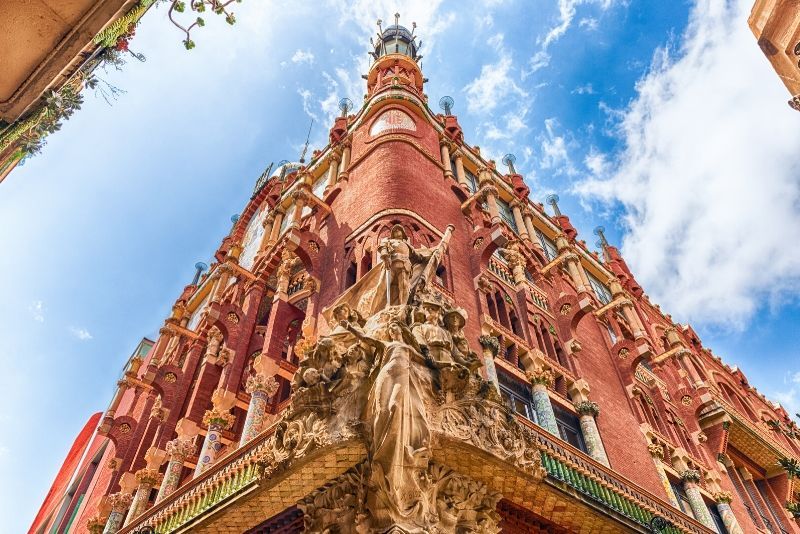
Check out our traveler's guide on Palau de la Música Catalana, one of the most exciting attractions in Barcelona.
What are the Palau de la Música Catalana ticket prices?
Palau de la Música Catalana self-guided tour tickets
- Adult ticket (ages 35-64): €17
- Youth ticket (ages 10-34): €12
- Children’s ticket (ages 9 and under): free
Palau de la Música Catalana audio guide tour tickets
- Adult ticket (ages 35-64): €19
- Youth ticket (ages 10-34): €13
- Children’s ticket (ages 9 and under): free
The audio guide is provided in the form of a downloadable app, so you’ll have to provide your own earphones to use it. The languages available are Catalan, Spanish, English, French, Italian, Korean and German.
Palau de la Música Catalana guided tour tickets
- Adult ticket (ages 35-64): €21
- Youth ticket (ages 10-34): €17
- Children’s ticket (ages 9 and under): free
Access to the theater is included in guided tour tickets, saving you the cost of having to buy separate entrance tickets. There are four in-house tours available daily, and they are operated in Catalan, Spanish, French, English and Italian.
Who can apply for discounts?
Palau de la Música Catalana is fully committed to making the theater accessible to as many people as possible. To achieve this, there are several discounts available when visiting Palau de la Música Catalana. You may be asked to produce proof that you qualify for the discount when entering the building.
Palau de la Música Catalana discounted tickets
- Visitors with disabilities and their caregiver (dependency of 1 or 2): €12
- Visitors with disabilities and their caregiver (dependency of 3): free
- Pensioner ticket (ages 65 and up): €17
Is there any need teo book in advance?
Absolutely — the building is still a fully functioning theater, hosting shows that may impact the number of tickets available for visits. This can make things tricky, especially if you are planning a visit to Palau de la Música Catalana over the weekend. Additionally, booking in advance allows you to choose a skip-the-line option, making entering the theater super convenient.
What types of Palau de la Música Catalana tours are there?
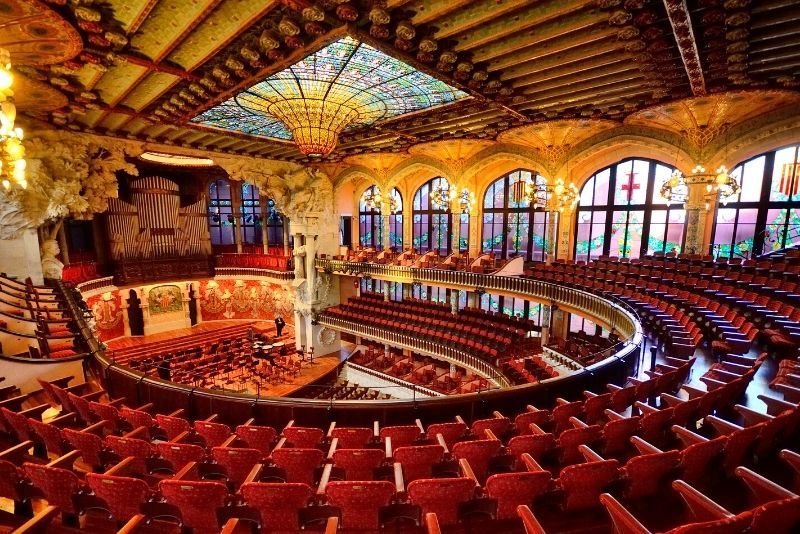
Self-guided tour of Palau de la Música Catalana
A self-guided tour is the most cost-efficient way of exploring the theater and it includes a comprehensive brochure to guide your steps. The written guide is included in your entrance ticket and is available in Catalan, Spanish, English, French, Italian, German, Portuguese, Russian, Japanese, Korean and Chinese.
The brochure will take you to every corner of this remarkable structure, illuminating hidden details along the way. The length of your tour is entirely up to you — a perk of being your own tour guide — but most people spent an average of 50 minutes inside.
Palau de la Música Catalana tour with audioguide
The audio guide tour option is a definite upgrade from the brochure-powered self-guided option, and it only costs a couple of Euros more. Remember to bring your own headphones because the guide is downloaded as an app.
This way, you’ll enjoy a visual and audio guided visit for a comprehensive experience of the theater's stunning interior and jaw-dropping architecture.
Guided group tour of Palau de la Música Catalana
A guided group tour of the Palau de la Música Catalana presents an experience that’s second to none — as your dedicated guide and theater employee escort you through the hallowed halls. You’ll explore every inch of this architectural marvel, from its foundations to its stained-glass edifices.
Your tour guide will also regale you with tales and anecdotes gathered over the 100 years plus of the theater’s existence — leaving you with an unforgettable tour experience.
Are there any combined tickets or tours including Palau de la Música Catalana?
Palau de la Música Catalana tour with Flamenco show
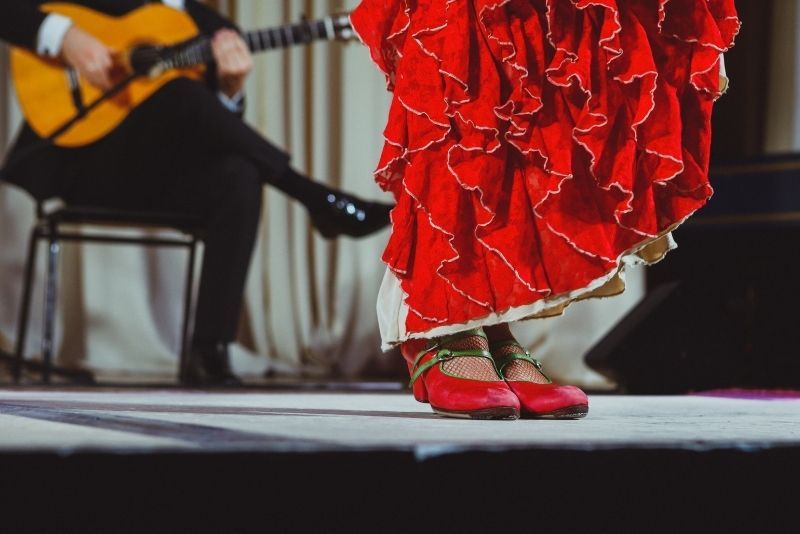
This combination tour allow you to take in all of the magic and splendor that the theater has to offer — after which you’ll get to experience the Palau de la Música Catalana in its full glory. A flamenco show in Barcelona is a must-see for everyone visiting the city and where better to experience it than in the famous theater?
Palau de la Música Catalana escape room
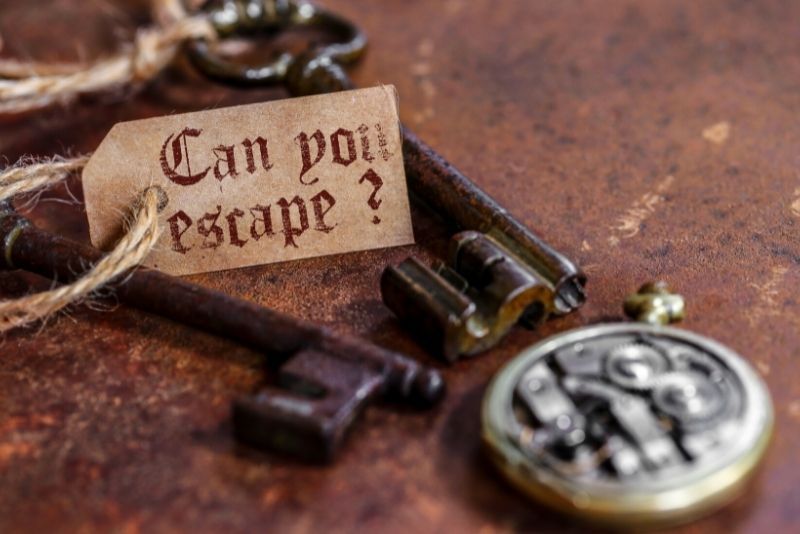
If you care more for mysteries and mental arithmetic than music, this combination tour with an escape room in Barcelona is perfect for you. You’ll have to keep all of your wits about you as you search for the plan of a nuclear bomb to thwart an evil dictator.
What will you see inside?
Viewed from outside, Palau de la Música Catalana looks more like an ornate temple than a theater and in some ways, it is — a structure dedicated to the reverential pursuit of human expression.
Step inside and you’ll soon realize the exterior is drab when compared to the interior of this magnificent building. Traveling from one intricately designed space to another, you’ll learn more about Lluís Domènech i Montaner, his vision and his other works — like the equally breathtaking Sant Pau.
What are the best travel options?
Palau de la Música Catalana is centrally located in Barcelona, nearby the Gothic Quarter and attractions like the Barcelona Zoo and Casa Batlló. It’s a 7-minute walk from Plaça de Catalunya — simply head down De Fontanella Street until you reach the theater district, from where you’ll be able to follow the signs.
What time of day can you visit?
Palau de la Música Catalana is open to the public every day of the week, right throughout the year. Typically, the theater can be visited from 9:00 AM to 3:30 PM. However, seeing as this is a functioning theater, available dates and visiting times are subject to change.
Is it wheelchair friendly?
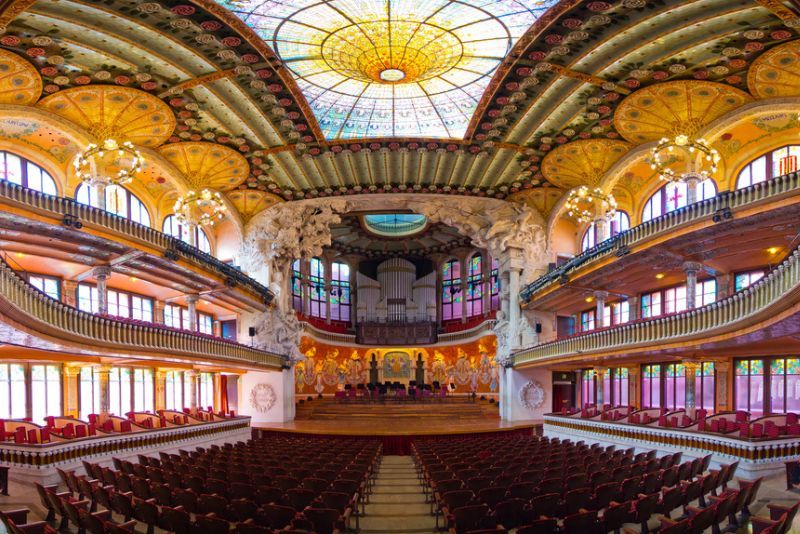
Palau de la Música Catalana is accessible to wheelchair users, with elevators available to reach areas normally serviced by stairs. A specialized wheelchair tour is also available, and it will visit all of the locations that other tour visit. Visually and aurally impaired travelers will also be catered to, ensuring that they’ll experience an unforgettable tour.
What time of year is best to visit the Palau de la Música Catalana?
The best time to visit the Palau de la Música Catalana is between April to June or September to November, during Barcelona's shoulder seasons. During this time, concerts span from classical to modern music, and the natural light brilliantly illuminates the intricate stained-glass. Guided tours are available all year round, but avoid national holidays to bypass crowds.
Which other attractions can you go to in Barcelona?
- Sagrada Família
- Park Güell
- Casa Milà
- Casa Batlló
- Camp Nou
- Montjuïc Cable Car
- Casa Amatller
- Gaudi Crypt
- Torre Bellesguard
- Santa Maria del Pi
Travel tips
- Concerts and guided tours can sell out quickly, so consider purchasing tickets online in advance.
- If planning to catch a performance, arrive early to find seats and settle in. While there's no strict dress code, semi-formal attire is recommended for evening performances.
- The Palau is in the city center, close to the Urquinaona metro station. This allows you to explore the nearby Gothic Quarter and El Born district before or after your visit.

